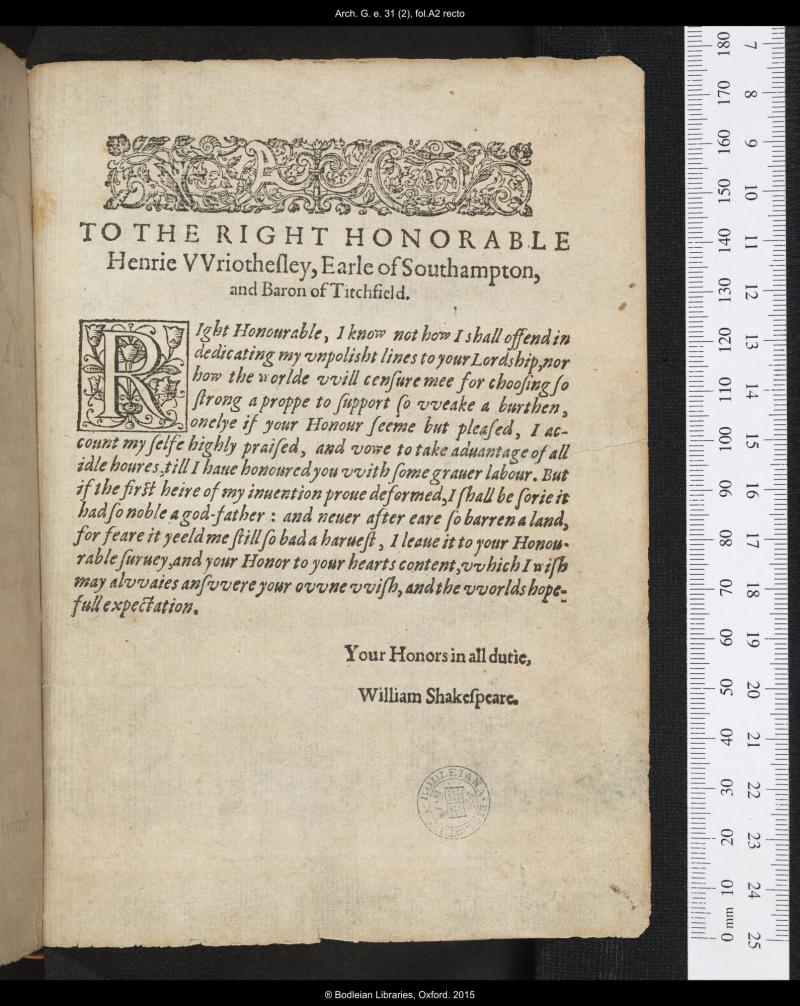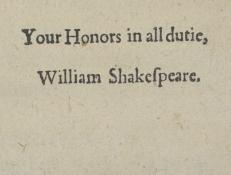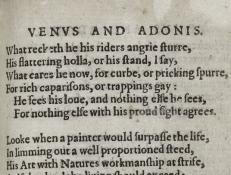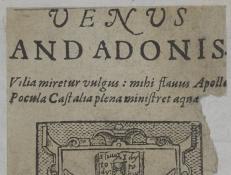Terms of use
The Bodleian Libraries, University of Oxford, has graciously contributed images of materials in its collections to Shakespeare Documented under the terms of a Creative Commons Attribution-NonCommercial 4.0 International licence. Images used within the scope of these terms should cite the Bodleian Libraries as the source. For any use outside the scope of these terms, visitors should contact Bodleian Libraries Imaging Services at imaging@bodleian.ox.ac.uk.
Copy-specific information
Creator: William Shakespeare
Title: Venus and Adonis
Date: London : Imprinted by Richard Field, 1593
Repository: Bodleian Library, Oxford University, Oxford, UK
Call number and opening: Arch. G. e.31 (2), title page & sig. A2r
View online bibliographic record
Adam G. Hooks, "Venus and Adonis, first edition," Shakespeare Documented, https://doi.org/10.37078/114.
Bodleian Library, Arch. G. e. 31 (2). See Shakespeare Documented, https://doi.org/10.37078/114.
This is the only known copy in existence of the first edition of Shakespeare’s first printed work, Venus and Adonis, which appeared in 1593. During his lifetime Shakespeare was known first and foremost as the author of Venus and Adonis. The erotic Ovidian poem made Shakespeare famous, and its influence on his reputation is difficult to overstate. It was printed almost twice as many times as his most successful play Henry IV Part 1, and was in fact the most popular work of vernacular poetry in the entire period.
The bold Latin motto on the title page—taken from Ovid’s Amores—proclaims Shakespeare’s ambition: “Let base conceipted witts admire vilde things, | Fair Phoebus lead me to the Muses springs” (in Christopher Marlowe’s All Ovid’s Elegies translation of the elegy). The poem was dedicated to Henry Wriostheley, the young earl of Southampton, and in the epistle Shakespeare calls the poem the “first heire of my inuention,” a recognition that it was his first published work. The well-printed quarto was produced by Richard Field, also from Stratford-upon-Avon. This fortuitous connection has long been interpreted as an indication that Shakespeare must have authorized the publication of the poem; Field’s role in producing the volume has thus sanctioned critical narratives that seek to determine Shakespeare’s own authorial ambitions.
While it is certainly plausible that Shakespeare took his poem to a fellow townsman—Field was not otherwise involved with vernacular poetry of this sort, and so would likely not have sought it out—this is not the only explanation. Field also relied on his partner John Harrison to sell the poem, since Harrison’s shop at the sign of the White Greyhound appears in the imprint. Field registered his right to the title on April 18, 1593 in the Stationers’ Register, but would later transfer the rights to Venus and Adonis to Harrison, on June 25, 1594. Harrison continued to hire Field to print four further editions of the poem, through 1596, when he transferred his rights to William Leake. The poem would reach a 16th edition before 1640.
This copy was previously owned by the seventeenth-century book collector Frances Wolfreston, who wrote her name and the phrase “hor bouk” on the title-page. It is now bound with another book once owned by Wolfreston, Giles Fletcher’s Licia, which (like Venus and Adonis) was also published in 1593. It is not clear if the two works were bound together in Wolfreston’s library; her name has been scrubbed out, and there is another owner’s name (“John Millway”) on the title-page of Licia, dated 1602. The Shakespearean scholar and editor Edmond Malone later acquired both works. Malone speculated that there must have been a 1593 edition of Shakespeare’s poem printed, and he spent many years searching for a copy, finally finding it in 1805 in the possession of William Ford, a Manchester bookseller. Malone paid the extravagant price of twenty-five pounds, and although he complained of the high price demanded by booksellers “taking advantage of the present rage for old English poetry,” he also claimed that “I do not at all repent my bargain,” since he obtained many valuable new textual variants. Malone's brother, Lord Sunderlin, inherited Malone's library on his death in 1812. In 1815, Sunderlin wrote to the Bodleian Library to present them with a portion of his brother's collection, including this first edition. Malone's library was finally received by the Bodleian in 1821, where the book remains part of the collection.
To learn more about the plot and early printing history of Venus and Adonis, please visit the Folger's Shakespeare's Works; to read a modernized edition of the poem, see the Folger Shakespeare edition.
Written by Adam G. Hooks
Sources
Personal correspondence with Sarah Wheale
Lukas Erne and Tamsin Badcoe, “Shakespeare and the Popularity of Poetry Books in Print, 1583-1622,” The Review of English Studies, n.s. 65, no. 268 (2013): 33-57.
Adam G. Hooks, Selling Shakespeare: Biography, Bibliography, and the Book Trade (Cambridge University Press, 2016).
Christopher Marlowe, The Complete Works of Christopher Marlowe, ed. Roma Gill, vol. I, Translations (Oxford University Press, 1987), 35.
Peter Martin, Edmond Malone, Shakespearean Scholar: A Literary Biography (Cambridge University Press, 1995).
Sasha Roberts, Reading Shakespeare’s Poems in Early Modern England (Palgrave Macmillan, 2003).
Last updated June 9, 2020














![Capell *.22[2], signatures A2 verso and A3 recto, thumbnail detail](https://shaxdoc.titania.folger.edu/sites/default/files/styles/document_thumbnail/public/document-thumbnails/Capell.star_.22_dedication%202_thumbnail%20detail.jpg?itok=SUhQBmMZ)








